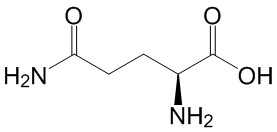Home
Products
L-Glutamine



| Product Name | L-Glutamine |
| Price: | $15 / 20mg |
| Catalog No.: | CN00671 |
| CAS No.: | 56-85-9 |
| Molecular Formula: | C5H10N2O3 |
| Molecular Weight: | 146.1 g/mol |
| Purity: | >=98% |
| Type of Compound: | Alkaloids |
| Physical Desc.: | Powder |
| Source: | The culture product of Escherichia coli. |
| Solvent: | Chloroform, Dichloromethane, Ethyl Acetate, DMSO, Acetone, etc. |
| SMILES: | NC(=O)CC[C@@H](C(=O)O)N |
| Contact us | |
|---|---|
| First Name: | |
| Last Name: | |
| E-mail: | |
| Question: | |
| Description | L-Glutamine is a non-essential amino acid present abundantly throughout the body and is involved in gastrointestinal disorders.Target: mGluRGlutamine (abbreviated as Gln or Q) is one of the 20 amino acids encoded by the standard genetic code. It is not recognized as an essential amino acid, but may become conditionally essential in certain situations, including intensive athletic training or certain gastrointestinal disorders. Its side-chain is an amide formed by replacing the side-chain hydroxyl of glutamic acid with an amine functional group, making it the amide of glutamic acid. Its codons are CAA and CAG. In human blood, glutamine is the most abundant free amino acid, with a concentration of about 500-900 μmol/L. Glutamine is synthesized by the enzyme glutamine synthetase from glutamate and ammonia. The most relevant glutamine-producing tissue is the muscle mass, accounting for about 90% of all glutamine synthesized. Glutamine is also released, in small amounts, by the lung and the brain. Although the liver is capable of relevant glutamine synthesis, its role in glutamine metabolism is more regulatory than producing, since the liver takes up large amounts of glutamine derived from the gut. The most eager consumers of glutamine are the cells of intestines, the kidney cells for the acid-base balance, activated immune cells, and manycancer cells. In respect to the last point mentioned, different glutamine analogues, such as DON, Azaserine or Acivicin, are tested as anticancer drugs. |
| Target | Human Endogenous Metabolite |
| Density | 1.5±0.1 g/cm3 |
| Boiling Point | 353.5±52.0 °C at 760 mmHg |
| Flash Point | 167.6±30.7 °C |
| Exact Mass | 146.069138 |
| PSA | 106.41000 |
| LogP | -1.28 |
| Vapour Pressure | 0.0±1.8 mmHg at 25°C |